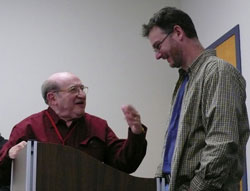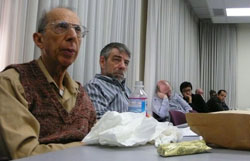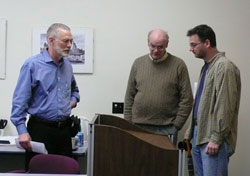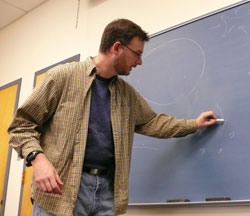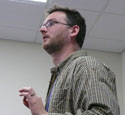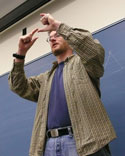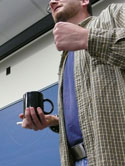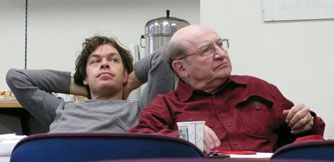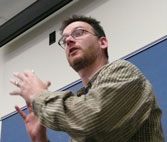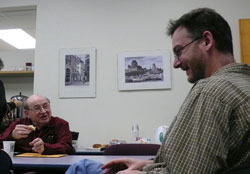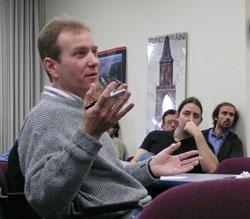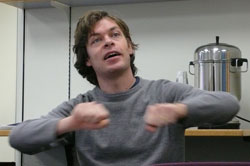

![]()
::: postdoc fellowships
::: senior fellowships
::: resident fellowships
::: associateships
![]()
being here
::: visiting
::: the last donut
::: photo album
::: center home >> being here >> last donut? >> 27 november 2007 |
Tuesday, 27 November 2007 Some debates in philosophy of science pass quickly. Probably only historians of philosophy can recall just what was at issue when the atomists engaged the corpuscularians in the seventeenth century. Yet there is one debate from this same era that persists today. Does space exist independently of the matter contained within it? That is, does it exists absolutely as Newton famously urged? Or is space nothing but the order of things, as his arch rival Leibniz urged, so that all spatial facts are just facts about relations between bodies?
Sitting to my left was Adolf's collaborator, Al Janis. Further in the room was John Earman, whose works have defined modern philosophy of space and time. And there were more--too many to name. Ed Slowik, a Visiting Fellow this term, has written much on space and spoke earlier in the lunchtime series on it. Finally there was me. I've been writing on philosophy of space and time for over 20 years. But in this room I still feel like a "Johnny come lately." It is a "good house."
What a relationist wants to say and perhaps ought to say is quite obvious. The infinity comes from possibilities. This fifth mass is, say, one foot away from the other masses. But it might have been two feet away, or three feet away, or four, or five, or six, or... well you see the idea. The infinity of space resides in the infinity of these possibilities. So far so good. But now how are we to make sense of this notion of possibility? Gordon begins to review a reductionist approach elaborated by Nick Huggett. We are now well into the talk. Gordon has prepared a four page handout of bullet points in ten point font. This is his script to which he speaks with real energy. We read along and watch him. He is a restless speaker and paces back and forth making wild gestures with his arms and hands, pausing from time to time to write something on the blackboard. I have trouble keeping him in the viewfinder of my camera and I am expecting plenty of near misses when I get to unload the shots from my memory card. In Huggett's approach, geometries emerge as summaries of the actual geometric facts. Say three points form a triangle with sides 3, 4, 5; and three more form a triangle with sides, 5, 12, 13; and there are a few more like this. Then we note that they all conform to the regularity of Pythagoras' theorem. The square of the hypotenuse in equal to the sum of the squares on the other two sides. We extract geometrical laws as these regularities. Of course it is not that easy. There are vastly more facts true of any set of bodies than we'd want to accept as laws. So Huggett avails himself of David Lewis' celebrated idea that laws are those truths that effect the best balance of simplicity and strength. The very complicated facts are strong, but not simple, so they don't count as laws. Some words excite an automatic response in philosophical circles. "Simplicity" is one. Adolf interjects, "What is simplicity in science? That is a hornet's nest!" His voice is measured and slow, with emphatic pauses. In any case, this is not Gordon's favored approach and he buries the overall proposal in a list of worries and objections. He then turns to another approach that he thinks shows more promise. The idea is to take certain notions of possibility as primitive, much as one might take the notion of a law as a primitive that extends beyond mere regularities among actual facts. Then, to specify the geometric properties of a system of five bodies, say, is to specify how this system might be embedded in bigger Euclidean space that is supposed full of matter and thus admissible by relationist lights. The fact of the possibility of this embedding just is a primitive geometric fact. We recover the infinity of space from the infinitude of this embedding space. Of course the details of how this will work are not so straightforward and Gordon takes to task of spelling them out with evident enthusiasm. The gestures continue. His hands are held high and he draws an intricate figure in the air, explaining, "The difference between this length and that length is..." He returns repeatedly to the blackboard to draw little geometric figures. A square with a line through it becomes a Moebius strip as points on this side are connected to points on that side. But this is an infinite Moebius strip and it illustrates the complications of embedding. We hear of congruences and mappings and configurations and "if and only if." Gordon is now worrying that his system is getting too complicated to follow. "I'm sorry the terminology is so unpleasant," he paused to say, "but the idea is entirely intuitive." And I thought it was. We ran out of time and all too soon had entered an energetic and wide ranging question period. Cian Dorr raised the concern that Gordon's system of embedding was merely an elaborate and indirect way of allowing transworld identity. Gordon did not think so and laid out a nice illustration of the difference. I was at the end of the queue and beginning to think that there'd be no time for my question. Finally I got to ask it. I was worried by the abundance of possibilities opened by the primitive facts of the new scheme. Might they just be the same facts as those of the substance view of space, but merely dressed in different language? Again Gordon did not think so. He despatched the worry with a simple but telling analogy. It is possible, he noted, for him to have children and grandchildren and so on; and it is a lawlike fact as to how these descendants would relate. Those possibilities, however, are different from actually having the children and grandchildren. The possibilities of the new scheme are organized in a lawlike way, but they are not assertions of the existence of spatial points. Gordon was in mid sentence when I noticed that it was 1:30pm and time to stop. Before the sentence was complete, I had produced the umbrella, presented it to him and called for a closing round of applause. John D. Norton Gordon Belot |
